Beneath the surface of Tophet lie chilling tales of ancient rituals, questioning the depths of human morality and biblical history.
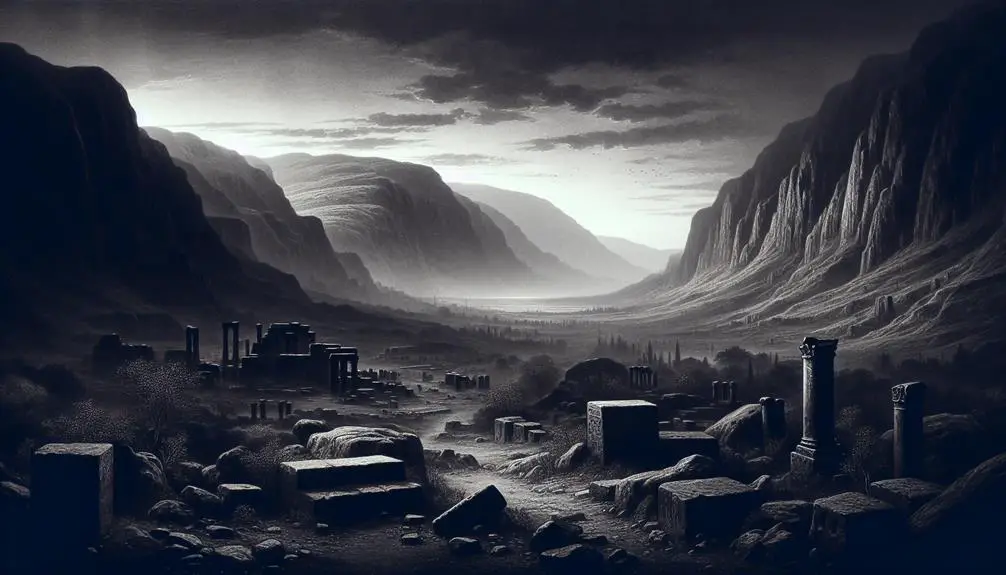
Tophet in the Bible
As you step into the shadows of ancient history, the tale of Tophet whispers a chilling reminder of humanity's darkest rituals. It's a place where biblical narratives intersect with archaeological mysteries, hinting at practices that might unsettle even the most seasoned scholars.
You'll find that Tophet isn't just a geographical location, but a symbol of profound theological and moral questions that echo through the ages. The stories and evidence surrounding child sacrifice there beckon you to look closer, challenging you to understand its historical context and its impact on contemporary views of morality.
What truths lie buried in this ancient ground?
Key Takeaways
- Tophet plays a critical role in biblical narratives, highlighting sacrificial practices and their religious significance.
- Prophetic denunciations in the Bible underscore the ethical concerns surrounding sacrificial rituals practiced in Tophet.
- Archaeological evidence from Tophet provides insights into ancient sacrificial ceremonies and their societal implications.
- The legacy of Tophet prompts ethical reflections on historical religious practices and their relevance to modern moral standards.
Historical Context of Tophet
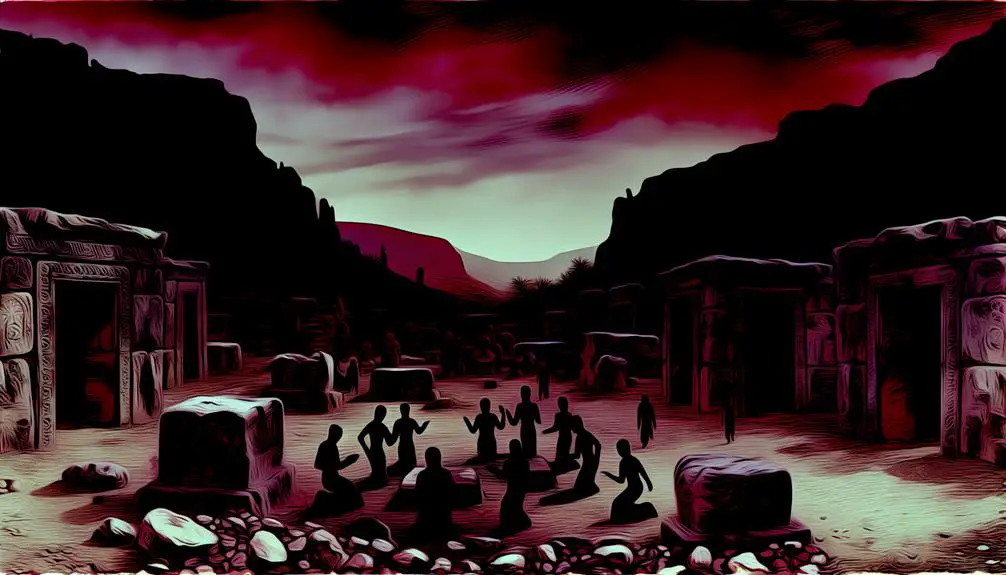
Historically, Tophet frequently emerges in discussions as a site of ancient religious practices, often linked to child sacrifice, within the context of Carthaginian and Israelite cultures. You'll find that scholars have meticulously dissected the cultural interpretations and ritual origins of these practices, aiming to understand the complex societal beliefs and values that underpinned them.
The term 'Tophet' itself is rooted in cultural interpretations, embodying a place where ancient rites were performed, possibly as offerings to deities or as part of a broader religious ceremony. These interpretations are crucial for you to grasp the multifaceted roles such rituals played in shaping identity and community cohesion within these ancient societies.
Delving into the ritual origins, it's evident that these practices weren't merely acts of faith but were intricately woven into the socio-political fabric of the time. They served as mechanisms for societal control, with the ruling elite possibly using them to reinforce authority or appease the gods during times of crisis. This analytical perspective allows you to appreciate the complex interplay between religion, power, and society in ancient times.
Moreover, the scholarly debate around the archaeological evidence of Tophet sites sheds light on the challenges you face in interpreting ancient practices. The lack of contemporaneous written records means that much of what you understand about these sites and their associated rituals is through the lens of later historical interpretations, further complicating your quest for objective truth.
As you delve deeper into the historical context of Tophet, it becomes clear that understanding these ancient practices requires a nuanced analysis of their cultural and ritualistic origins, untangling centuries of scholarly interpretations to reveal the underlying societal dynamics.
Tophet in Biblical Narratives
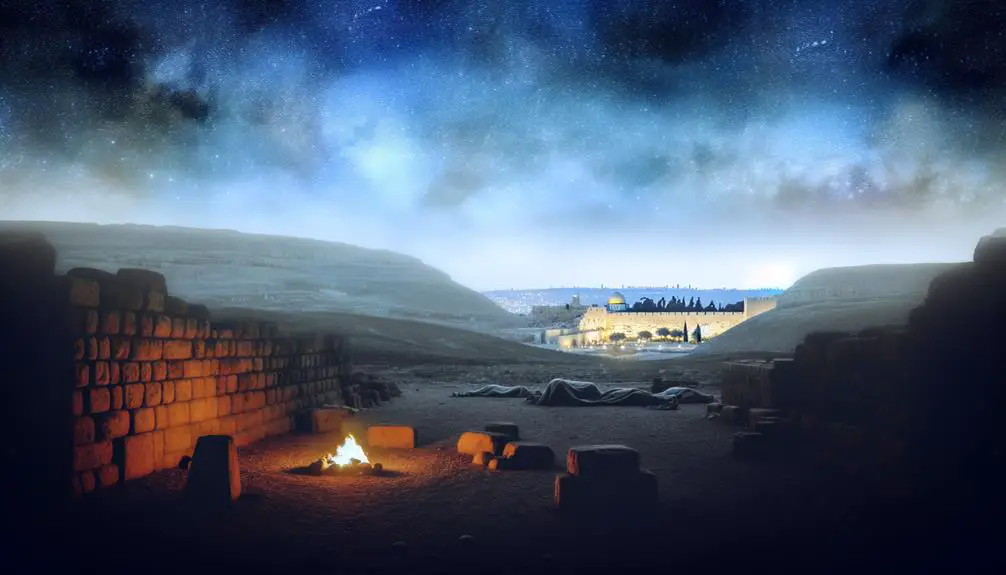
You'll find that Tophet's location and significance are intricately woven into the fabric of biblical narratives, highlighting its role within the socio-religious landscape of the time.
The texts describe sacrificial practices in detail, offering a lens through which to understand the complex interplay between religion and society.
Additionally, the prophetic denunciations addressed to Tophet provide critical insight into the ethical and moral debates that shaped the religious community's evolution.
Tophet's Location and Significance
Tophet's strategic positioning in the Valley of Hinnom, just outside Jerusalem, bears significant theological and historical implications within biblical narratives. This locale isn't merely a geographic reference but a site loaded with religious interpretations and scholarly debates. Geographical theories regarding Tophet's exact location have evolved, reflecting the complex relationship between the physical landscape of ancient Israel and its spiritual significance.
- Geographical theories suggest varying locations within the Valley of Hinnom.
- Religious interpretations often associate Tophet with judgment and purification.
- The proximity to Jerusalem highlights its relevance to Judean society.
- Archaeological findings provide tangible links to ancient practices.
- Scriptural references to Tophet underscore its ominous reputation.
Analyzing Tophet's location and significance offers a window into the intertwining of geography, religion, and culture in biblical times.
Sacrificial Practices Described
While examining biblical narratives, it becomes evident that sacrificial practices in Tophet were deeply intertwined with the religious and cultural milieu of ancient Judean society. These rituals, often involving offerings to deities, reflect a complex relationship between faith, tradition, and societal norms.
You'll find that the ethical implications of such practices invite rigorous scrutiny, especially when drawing modern parallels. In today's context, the examination of ancient sacrificial rites in Tophet challenges you to consider the evolution of moral perspectives and religious practices.
This analysis not only sheds light on the historical significance of these rituals but also prompts a critical evaluation of contemporary religious and cultural practices, highlighting how past beliefs continue to influence present ethical standards.
Prophetic Denunciations Addressed
In biblical narratives, prophets vehemently denounced the sacrificial practices in Tophet, framing them as contrary to the will of the divine. These prophetic denunciations aren't mere historical footnotes; they carry significant ethical implications and modern parallels that challenge us to reflect on our own societal practices.
- Ethical implications: Scrutinizes the morality of sacrificial practices.
- Modern parallels: Draws connections between ancient rites and contemporary issues.
- Divine will: Explores the concept of divine morality versus human actions.
- Prophetic authority: Analyzes the role and influence of prophets in shaping moral standards.
- Societal reflection: Encourages introspection on current practices that might parallel ancient sacrificial rites.
This analysis invites you to consider how ancient criticisms can inform our understanding of ethical conduct and societal norms today.
The Practices of Child Sacrifice
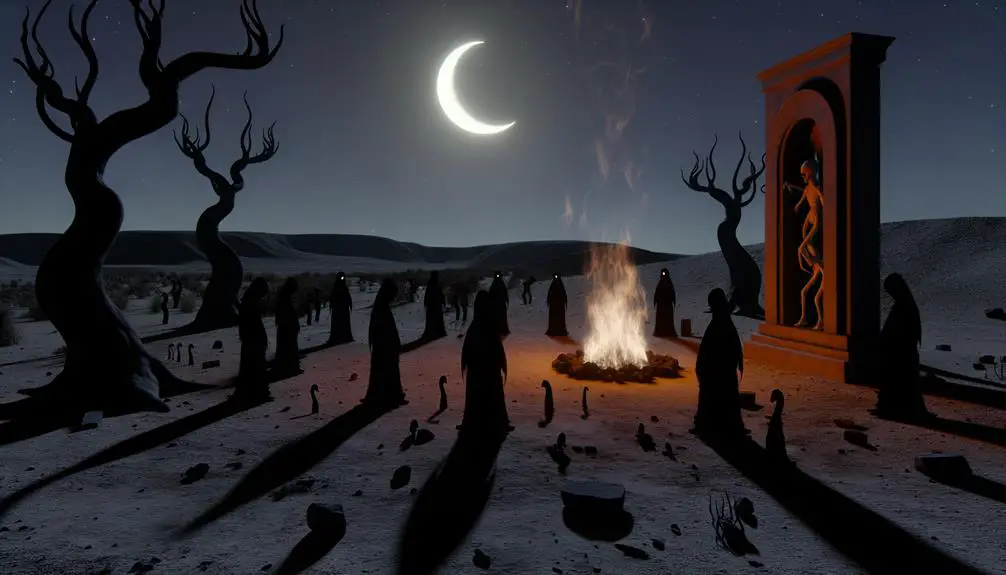
ARTICLE TITLE: Tophet in the Bible
PREVIOUS SUBTOPIC: 'Prophetic Denunciations Addressed'
CURRENT SUBTOPIC: 'The Practices of Child Sacrifice'
How did ancient societies justify the grim practice of child sacrifice, a ritual that has been historically associated with the Tophet? You might find it challenging to comprehend, yet these societies believed in the necessity of such sacrifices for the appeasement of gods, hoping for benefits or to avert disasters. This belief system underscores the profound impact of religious and cultural norms on ethical practices.
Exploring the modern parallels, it's evident how societal norms continue to shape ethical reflections. Today's ethical dilemmas, though not as extreme, still pose questions about the lengths societies will go to uphold certain beliefs or achieve perceived collective goals. This comparison prompts a deeper understanding of the complexities surrounding ethical reflections in both ancient and modern contexts.
Factor |
Ancient Context |
Modern Parallels |
|---|---|---|
Belief |
Appeasement of gods |
Societal norms/values |
Method |
Child sacrifice |
Varied ethical dilemmas |
Justification |
Divine favor, avoid calamity |
Achieve/avoid societal goals |
Reflection |
Ethical complexities |
Continues in modern dilemmas |
This table illustrates how ancient practices like those associated with the Tophet and contemporary ethical challenges share underlying themes of belief, justification, and reflection. While the specifics have evolved, the fundamental human engagement with ethical complexities remains constant. Engaging in this analysis not only provides insights into historical practices but also encourages a reflective stance on today's ethical challenges, fostering a deeper understanding of the continuity and evolution of human ethical thought.
Tophet's Archaeological Evidence
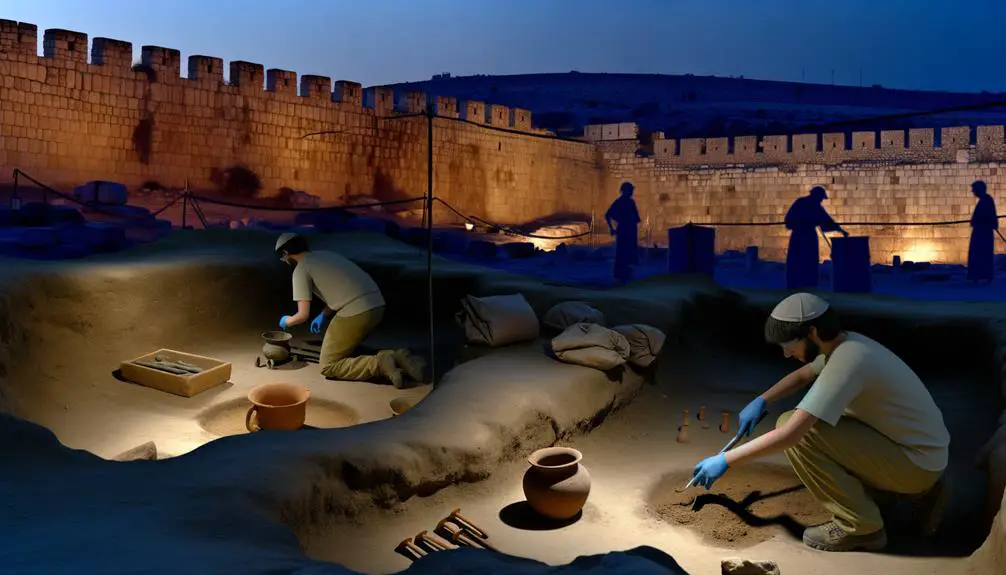
Archaeological discoveries have shed light on the practices associated with Tophet, revealing tangible evidence of the ritualistic child sacrifices once performed. Through meticulous excavation and analysis, scholars have pieced together a clearer picture of these ancient ceremonies, underscoring the depth of cultural and religious practices in the civilizations that participated in them. Radiocarbon dating has been instrumental in establishing timelines, while the examination of artifacts has drawn cultural parallels, illustrating a wider geographical and temporal scope of such rituals.
To hook you further, here's an in-depth look at the findings:
- Radiocarbon dating of bone fragments has pinpointed the periods during which these sacrifices occurred, providing a chronological framework that aligns with historical accounts.
- Ceremonial artifacts, including pottery and inscriptions, offer insights into the rituals, their significance, and their role within the society.
- Analysis of burial sites reveals a systematic approach to the sacrifices, with patterns in the age and treatment of the remains that underscore the ritualistic nature.
- Cultural parallels in nearby regions, identified through comparative studies, suggest a broader practice of child sacrifice, highlighting a complex web of religious and cultural interconnections.
- Architectural remains of ceremonial sites, such as altars and temples, provide a spatial context for the rituals, offering clues about the ceremonial processes and the social organization of the spaces.
Through these findings, you gain not just a glimpse into the grim practices of the past, but also an understanding of the cultural and religious dimensions that shaped them.
Prophetic Denunciations of Tophet
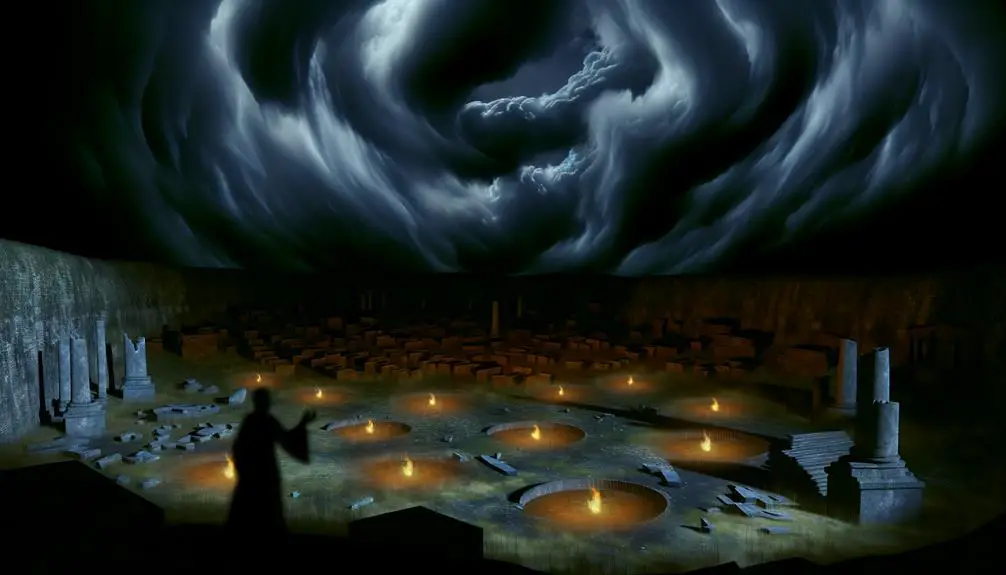
Biblical prophets vehemently condemned Tophet, decrying its practices as abhorrent to the principles they upheld. They viewed Tophet not merely as a physical location but as a symbol of profound moral decay within society. These prophets, acting as the moral compass of their time, leveraged their position to issue dire warnings about the divine judgments that awaited those who perpetuated the rituals associated with Tophet. Their denunciations are embedded within a broader theological framework, emphasizing a divine mandate against practices they saw as inimical to the covenant relationship between the divine and humanity.
The moral implications of participating in or condoning the activities of Tophet were profound. Prophets like Jeremiah and Isaiah highlighted these implications, positioning them within a narrative of divine justice and retribution. They argued that the actions carried out in Tophet weren't just offensive to divine sensibilities but were fundamentally at odds with the ethical demands placed upon the people. The consequence of these actions, they warned, would be severe divine judgments, manifesting as societal upheaval, exile, and destruction.
These prophetic denunciations served multiple purposes. They were a call to repentance, an appeal for societal reform, and a warning of the inevitable consequences of continuing down a path contrary to divine statutes. The prophets' messages underscored the belief that societal practices and moral conduct were deeply intertwined with the community's spiritual health and its relationship with the divine. Through their vehement opposition to Tophet, the prophets sought to steer their society back towards a path aligned with divine will and moral rectitude.
Lessons From Tophet's Legacy
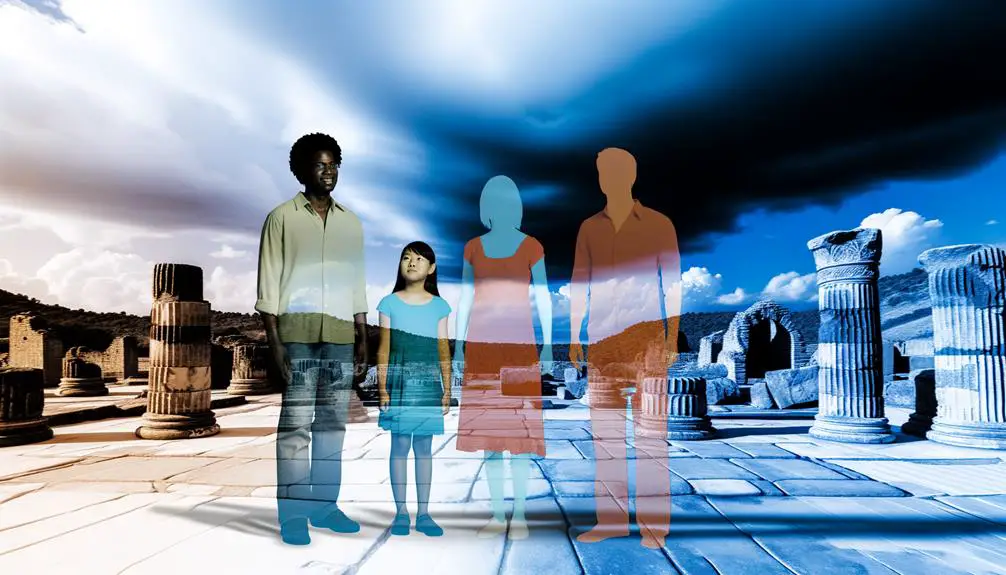
Tophet's legacy offers invaluable lessons on the consequences of societal actions that contravene moral and divine laws. As you delve deeper into its historical and biblical context, you're invited to reflect on how these ancient narratives hold relevance in contemporary discussions about ethics and morality. The examination of Tophet not only uncovers the past but also prompts critical ethical reflections and modern interpretations of ancient practices.
- Historical Context and Moral Lessons: Understanding the historical backdrop of Tophet illuminates the dangers of societal practices that violate ethical norms.
- Divine Laws vs. Human Actions: The juxtaposition of divine commandments against human actions in Tophet's story emphasizes the importance of aligning societal laws with moral and ethical values.
- Modern Interpretations: The narrative of Tophet invites modern readers to interpret ancient texts in a way that resonates with today's ethical challenges, encouraging a reevaluation of contemporary practices.
- Ethical Reflections: Tophet's story serves as a catalyst for ethical reflections, questioning the morality of actions taken by societies, both ancient and modern.
- Learning from History: The legacy of Tophet teaches the importance of learning from historical mistakes to avoid repeating them in the present and future.
These aspects of Tophet's legacy underscore the significance of historical and biblical narratives in shaping our understanding of ethics and morality. They challenge you to consider how ancient lessons can guide contemporary societal choices, ensuring that the actions of today don't mirror the moral missteps of the past. Through ethical reflections and modern interpretations, the story of Tophet remains a powerful tool for understanding the complex relationship between divine laws and human actions.
Frequently Asked Questions
How Has the Interpretation of Tophet's Role and Significance Evolved Among Different Religious Denominations Over Time?
You've noticed that the understanding of Tophet's role has changed over time. Initially, its origins and significance were interpreted differently across various faith groups. Denominational interpretations have shifted, reflecting broader theological evolutions.
As scholars dive deeper, they uncover nuances that challenge old views. By comparing these insights, you see a rich tapestry of beliefs that highlight how religious understandings adapt and grow, keeping the discourse both vibrant and complex.
Are There Any Modern Cultural or Literary References to Tophet That Indicate Its Impact on Contemporary Society?
You might find it fascinating that Tophet has influenced modern society in subtle ways. Its literary symbolism and cultural resurgence are evident in various forms of media, reflecting its historical and theological implications.
This concept has seeped into novels, films, and art, serving as a metaphor for judgment or redemption. Analyzing these references, you'll uncover how Tophet's legacy shapes contemporary themes, inviting a deeper understanding of its enduring impact.
How Do Scholars Reconcile the Historical and Archaeological Evidence of Tophet With the Biblical Narratives?
You're navigating a complex puzzle where geographical inconsistencies and methodological criticisms are the pieces. Scholars tread carefully, piecing together archaeological discoveries with ancient texts, aiming to bridge gaps between historical evidence and narratives.
They weigh each shard and scroll, scrutinizing for a clearer picture. Your journey through this scholarly terrain isn't just about reconciling facts; it's an exploration into how history and faith can intertwine, shedding light on ancient practices and beliefs.
What Psychological or Sociocultural Factors Might Have Influenced the Practices Associated With Tophet, Outside of Religious Obligations?
You're looking at how psychological or sociocultural factors, beyond religious obligations, might've influenced certain ancient practices. Urbanization pressures and war traumas could have played significant roles.
As societies expanded and faced the stress of war, these pressures may have shaped rituals and beliefs, leading to practices aimed at coping with societal stress, seeking protection, or invoking favor from higher powers.
Analyzing these aspects offers insights into the complex human behaviors of the past.
Can Parallels Be Drawn Between the Rituals Performed at Tophet and Those in Other Ancient Civilizations Not Mentioned in the Bible?
Certainly, you're opening a can of worms by comparing ancient rituals across civilizations.
Delving into this inquiry, ancient parallels and ritual comparisons show that various cultures practiced similar rites, often involving sacrifices or elaborate ceremonies to appease deities or honor the dead.
These practices weren't unique to one group but spanned across continents, suggesting a universal human inclination towards ritualistic behavior to express spirituality, seek protection, or ensure prosperity.
Conclusion
In the shadow of ancient ruins, Tophet whispers tales of sorrow and warning. Its legacy, unearthed by archaeologists, bears grim testimony to practices once shrouded in sacred secrecy. Through the lens of scripture, prophets vehemently denounced these rituals, casting them as moral abysses.
Analyzing Tophet's dark narrative, one discerns not just a historical curiosity, but a profound lesson on the fragility of ethics amidst societal pressures. It stands as a solemn beacon, urging reflection on the values we cherish and the legacies we leave behind.

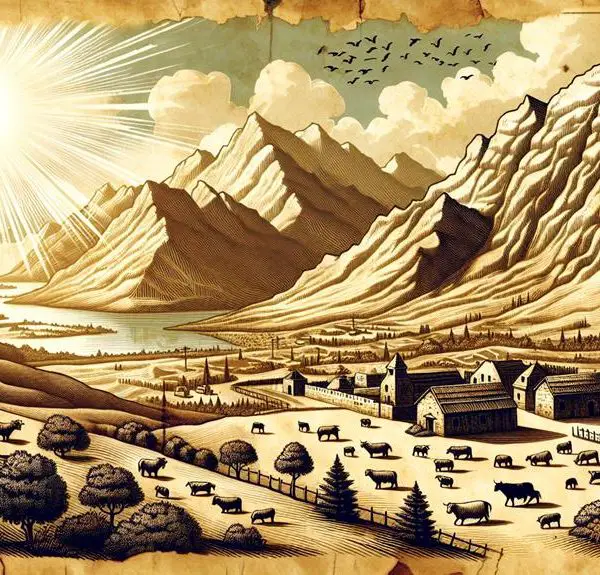
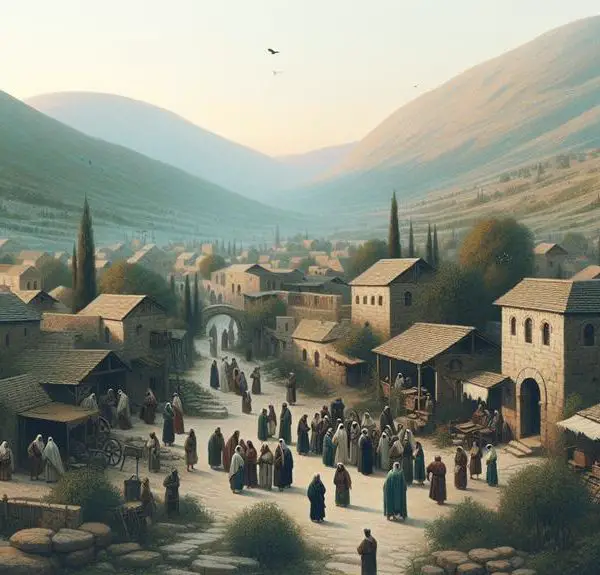
Sign up